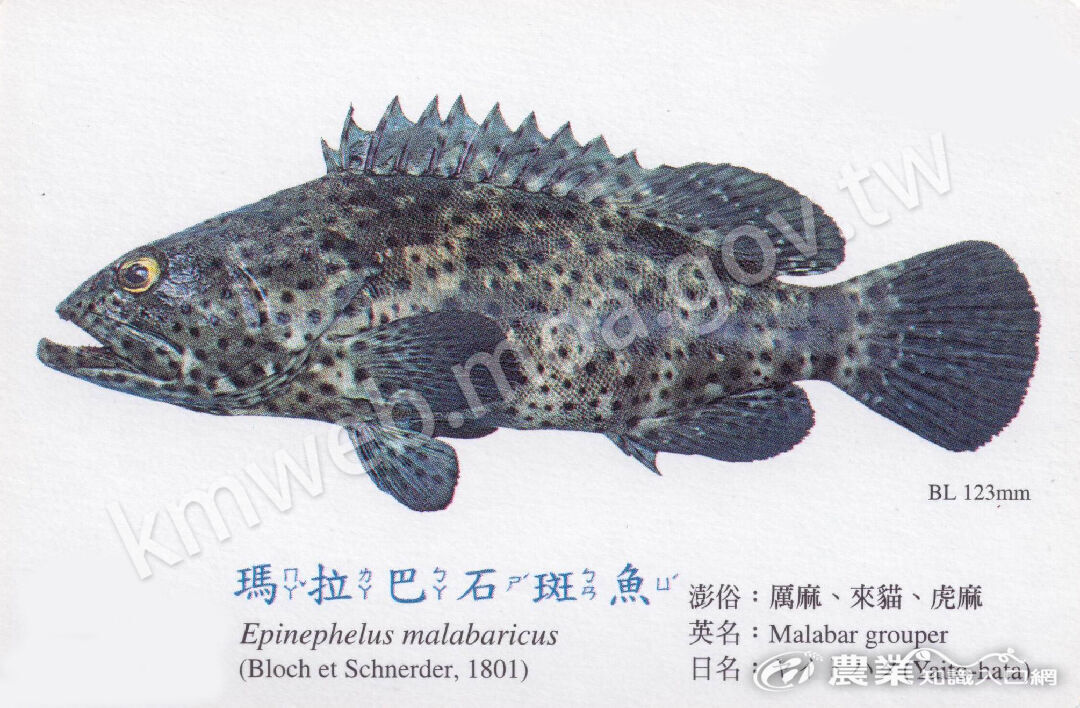瑪拉巴石斑 (Epinephelus malabaricus),俗名土斑、青斑,英文名Malabar grouper。外觀體型為長橢圓形,側扁而粗壯,標準體長為體高之3.0-3.7倍。體色呈淺褐色,有五條微斜之暗色褐帶,帶內有白色斑點分佈,而全身則分部黑色斑點。瑪拉巴石斑很容易和點帶石斑(E. coioides)混淆,主要的差別在點帶石斑的體色呈橘色或紅褐色,且體側斑點也為橘紅色。
瑪拉巴石斑的分布在印度至西太平洋之暖水域,西起非洲東岸、紅海,東至東加,北至日本,南至澳洲。台灣則是分布在北部、東部及南部海域。棲地相當多樣化,從珊瑚礁區、石礫區、潮池、河口區或泥沙底區皆可看見其蹤跡。肉食性,主要以魚類、甲殼類及頭足類為食。
瑪拉巴石斑的人工繁殖技術已經被建立,在1990年代是主要的養殖石斑。野生石斑的捕獲方式則是透過拖網、延繩釣、魚槍或一支釣等漁法捕獲。烹調上以清蒸、清湯風味最佳。
參考文獻:
1. Leu, M. Y., Liou, C. H., & Fang, L. S. (2005). Embryonic and larval development of the malabar grouper, Epinephelus malabaricus (Pisces: Serranidae). Marine Biological Association of the United Kingdom. Journal of the Marine Biological Association of the United Kingdom, 85(5), 1249.
2. Ruangphanit, N., Boonliptanon, P., & Kongkumnerd, J. (1993). Progress of the propagation and larval rearing of the grouper, Epinephelus malabaricus. In Seminar on Grouper Culture, Songkla (Thailand), 30 Nov-1 Dec 1993.
3. 邵廣昭 臺灣魚類資料庫 網路電子版
http://fishdb.sinica.edu.tw, (2023-11-4) |
|


Malabar Grouper (Epinephelus malabaricus)
The Malabar grouper, also known as tǔ bān or qīng bān in Chinese, has an elongated oval-shaped body that is laterally compressed and robust. Its standard length is approximately 3.0 to 3.7 times its body height. The body color is light brown, featuring five slightly oblique dark brown bands with white spots distributed within the bands. The entire body is also covered with black spots. This species is often confused with the orange-spotted grouper (E. coioides), which has a more orange or reddish-brown body color and orange-red spots on its sides.
Malabar grouper is distributed in warm waters from the Indian Ocean to the Western Pacific. Its range extends from the eastern coast of Africa and the Red Sea in the west to Tonga in the east, reaching Japan in the north and Australia in the south. In Taiwan, it can be found in the northern, eastern, and southern waters. This species inhabits a diverse range of environments, including coral reefs, rocky areas, tide pools, estuaries, and muddy or sandy bottoms. It is carnivorous, primarily feeding on fish, crustaceans, and cephalopods.
The artificial breeding technology for Malabar grouper has been established, and it was one of the primary grouper species cultured in the 1990s. Wild Malabar groupers are caught using trawl nets, longlines, spearfishing, or hand lines. In culinary applications, steaming or making clear soup brings out the best flavor.